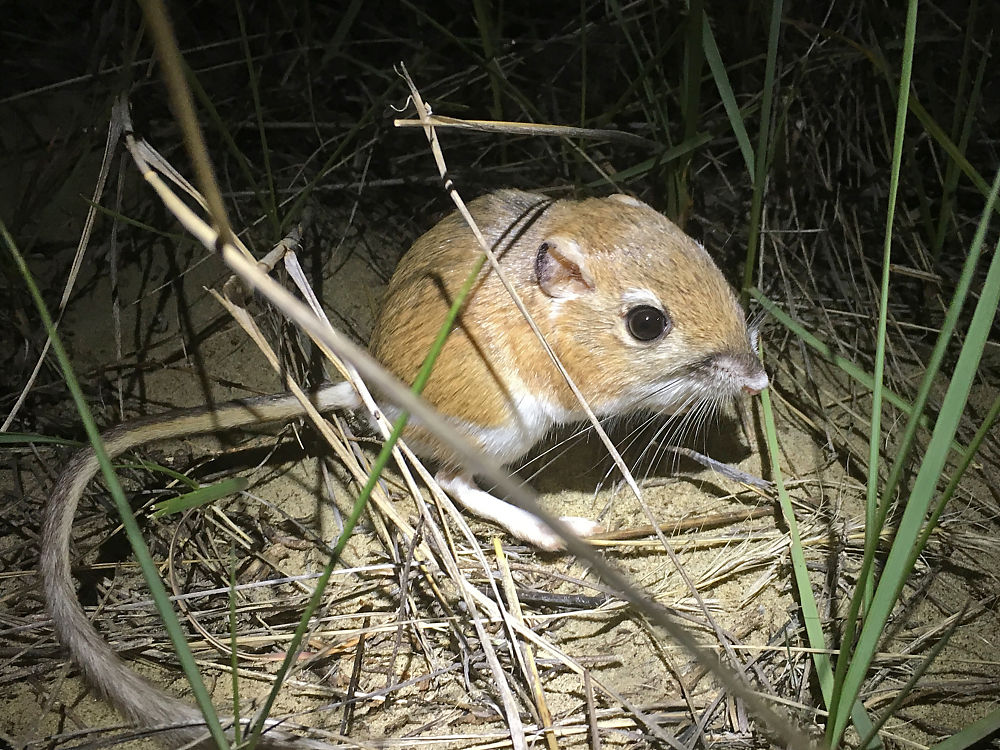Recovery of Ord’s Kangaroo Rats on the Suffield National Wildlife Area

BY PAT FARGEY
I feel my spirits lift as I clear the city limits of Edmonton and start my drive through Alberta’s parkland. It is the middle of October and I can see that fall rains have frustrated the harvest. Watching the flights of ducks and geese that are taking advantage of the crops still in the fields helps pass the time. I am headed to Medicine Hat to meet up with my friend and colleague Sandi Robertson. I am going to help her with a kangaroo rat project on the Suffield National Wildlife Area (SNWA). Though I have paddled by the SNWA on the South Saskatchewan River, this will be my first opportunity to properly tour this fascinating area because access to the SNWA is strictly controlled by the military at Canadian Forces Base Suffield.
Sandi did her Master’s thesis on Ord’s kangaroo rats, and in 2014 she was able secure her dream job as a biologist with Alberta Environment and Parks out of the Medicine Hat office. The recovery of kangaroo rats was now part of her job. Good for her and definitely good for the recovery of kangaroo rats.
Ord’s kangaroo rat (Dipodomys ordii) is one of the 19 species that occur in the genus Dipodomys. It is also the most widespread species, with 32 recognized subspecies. It is found throughout the arid grasslands and deserts of North America, extending up into the sandy soils and dunes of southeastern Alberta and southwestern Saskatchewan. Kangaroo rats get their name from their large back legs and feet that they use to hop in a fashion reminiscent of Australian kangaroos. They are sometimes confused with the smaller western jumping mouse, which is also a hind foot jumper.
Canadian kangaroo rat populations have been separated for many thousands of years from US populations, the closest of which is 270 km away in north-central Montana. They have been listed as an endangered species in Canada since 2007. In Alberta, their occurrence is limited to an area of approximately 1,700 km2, mostly between the Red Deer and South Saskatchewan Rivers. Their core range includes the Middle Sand Hills region, most of which is in the SNWA, as well as two sand dune complexes near Bindloss and Empress.
Kangaroo rats naturally inhabit sand dune complexes but can also occupy man-made habitats like fallow fields, sandy trails and fireguards. These man-made habitats have been studied by University of Calgary professor, Darren Bender, and his grad students. Their results suggest that man-made habitats are of lower quality than natural habitats. The causes of this difference are not fully understood but are thought to involve some combination of human disturbance (traffic, cultivation, etc.), the presence of invasive plants whose seeds are less nutritious or do not store as well as native seeds, elevated predation rates because of the availability of raptor perches on fences and power poles, and a much higher rate of parasitism by bot flies. The kangaroo rat population in these man-made habitats is likely being maintained by dispersal from populations in nearby natural dune habitat. As we will see, the kangaroo rats on this man-made habitat are important to the story.
As recently as the early 2000s, the SNWA kangaroo rat population numbered in the thousands but it has been in decline since. A survey conducted by Sandi in 2016 suggests that only 60–80 individuals remain in five isolated sand dunes in the northeastern portion of the SNWA. This decline is thought to have been caused by a combination of dunes becoming overgrown with vegetation, extreme weather events, harsh winters, and damage from elk.
Using remote cameras and burrow surveys, Sandi recently determined that elk may be a bigger problem than previously understood. Two hundred elk were introduced to the SNWA in 1997 and their population has expanded rapidly since then, peaking at over 7,000 animals before hunting was initiated in 2012. For whatever reason, elk spend a lot of time on the dunes, and their hooves can collapse kangaroo rat burrows and kill kangaroo rats. The magnitude of this effect on kangaroo rat populations has yet to be determined, but Sandi thinks it has the potential to be very significant when it leads to burrow abandonment, loss of food caches (particularly in the winter) and direct mortality.
Sandi’s plan to increase the population of kangaroo rats in the SNWA is simple in its conception but logistically challenging in execution. Step 1 is to improve the dune habitat in the SNWA. For her first project, she has picked a set of dunes that once had a thriving population of kangaroo rats but has become overgrown with blue grama grass and club moss. This overgrowth reduces the ability of kangaroo rats to forage effectively because the dense vegetation impairs their ability to move around rapidly, and desirable food plants like scurf pea, needle and thread grass, and Indian rice grass are less abundant. A double whammy!
The solution is to execute a prescribed burn of sufficient intensity to generate a mosaic of desirable cover and forage species embedded in a matrix of exposed sand. Easy to say, tough to do. Fortunately, Environment and Climate Change Canada has a long history of using prescribed fire in conservation applications. In 2018, Kerry Hecker, a protected areas manager, lead a team of six people who successfully burned two dunes, totalling 42 ha. They attempted another burn the fall of 2019, but with less success because of difficult burning conditions.
Pat Fargey is a species at risk biologist with Alberta Environment and Parks. This article originally ran in Nature Alberta Magazine - Spring 2020